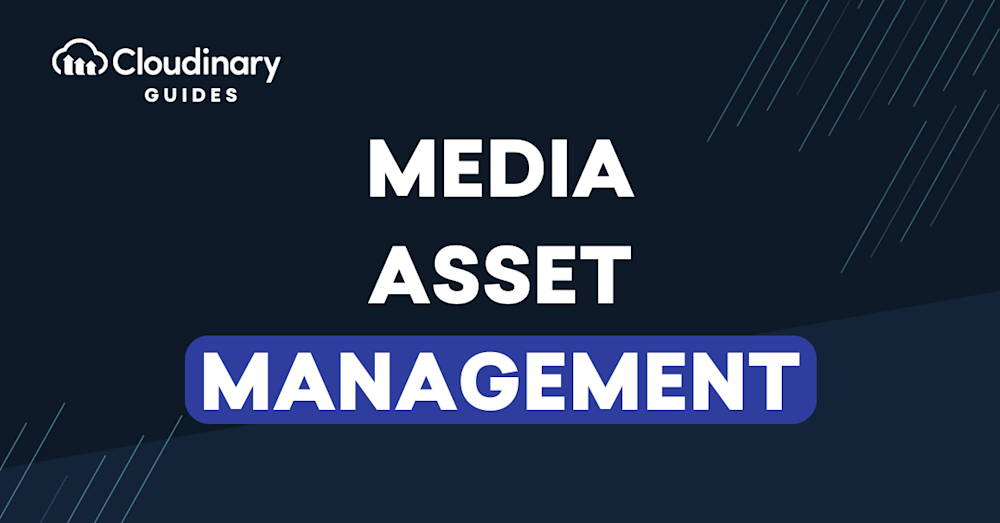Media asset management (MAM) is a system designed to efficiently store, organize, and retrieve media files such as images, videos, audio files, and documents. It enables businesses and individuals to streamline their media workflows, ensuring easy access, collaboration, and distribution of digital assets.
MAM systems incorporate metadata tagging, search functionalities, and automated workflows to help users manage large volumes of content. These tools are particularly valuable for industries that rely on media-rich content, including broadcasting, marketing, entertainment, and e-commerce.
By leveraging a robust MAM solution, organizations can improve efficiency, enhance collaboration, and maximize the value of their media assets, ultimately supporting better brand communication and audience engagement.
By using a digital asset management system, marketers can save valuable time when searching for and retrieving digital assets. This significant time-saving benefit underscores the importance of implementing effective media asset management strategies in your organization. In this guide, we will delve into the world of media asset management and explore how it can help you streamline your workflow, improve collaboration, and ultimately, boost your overall productivity.
In this guide:
- What is Media Asset Management
- The Benefits of Media Asset Management
- Key Features of Media Asset Management Systems
- What is Media Asset Management Workflow Orchestration?
- What’s the Difference between VAM, DAM & MAM?
- Factors to Consider When Choosing a Media Asset Management System
- Who needs Media Asset Management?
- Implementing Media Asset Management in Your Organization
- How can Cloudinary help with your media asset management requirements?
What is Media Asset Management?
Media Asset Management (MAM) is a comprehensive system that streamlines the organization, storage, and retrieval of digital assets, such as images, video files, audio files, and documents. It plays a crucial role in ensuring these valuable assets are easily accessible, well-organized, and efficiently managed, ultimately saving time and resources for businesses and individuals alike. By implementing a MAM system, organizations can improve collaboration, maintain brand consistency, and enhance overall productivity, making it an indispensable tool in today’s fast-paced digital landscape.
The Benefits of Media Asset Management
MAM systems offer a wide array of benefits that can significantly improve the way organizations handle their digital assets. By implementing one, users can expect to enjoy the following advantages:
- Improved organization and searchability. Easily categorize, tag, and locate assets using metadata and search functions.
- Streamlined workflows and collaboration. Facilitate seamless sharing, editing, and approval processes among team members.
- Enhanced security and access control. Protect sensitive assets with customizable user permissions and secure storage options.
- Time and cost savings. Reduce the time spent searching for and managing assets, leading to increased efficiency and cost-effectiveness.
- Brand consistency and compliance. Ensure all assets adhere to brand guidelines and legal requirements, maintaining a cohesive and compliant brand identity.
- Analysis across digital files. MAM enables you to analyze media files across an entire database based on their metadata, providing insights like the percentage of foreign-language shows in a TV database, the best-rated US-produced shows, or the number of episodes featuring a specific actor.
- Easy Search. With a Media Asset Management solution, searching for the right digital media assets becomes effortless, as you can segment and search files using metadata tags such as upload date, title, themes, and more.
Key Features of Media Asset Management Systems
Media Asset Management systems offer a wide range of features designed to optimize the handling of digital assets. Let’s explore these key features in more detail.
Centralized storage
These systems consolidate all your digital assets in one centralized location, providing a single source of truth for your organization. This makes accessing, sharing, and managing them across your organization easier. This eliminates the need to navigate through multiple storage locations and reduces the risk of losing or duplicating assets.
Metadata management
Efficient metadata management allows you to categorize and tag assets with relevant information, such as keywords, descriptions, and usage rights. This makes it easier for users to locate and manage assets based on specific criteria, streamlining the search and retrieval process.
Advanced search capabilities
MAM systems offer powerful search functions that enable users to quickly find the needed assets by filtering results based on keywords, metadata, file type, and other parameters. This saves time and ensures that the right assets are used in the right context.
Access control and user permissions
You’re able to customize access levels and user permissions, ensuring that only authorized individuals can view, edit, or share specific assets. This enhances security and prevents unauthorized access or misuse of sensitive assets.
Integration with other tools and platforms
These systems can seamlessly integrate with other software and platforms, such as content management systems (CMS), marketing automation tools, and social media networks. This enables users to easily access and utilize assets across multiple channels, streamlining workflows and improving overall efficiency.
Version control and history tracking
MAM systems provide version control and history tracking features that enable users to keep track of all changes made to assets, including edits and updates. This allows for easy retrieval of previous versions and provides a clear audit trail, ensuring that the most up-to-date assets are used and reducing the risk of errors.
Automation and artificial intelligence
Many of these systems leverage AI-powered features to automate repetitive tasks, such as tagging and categorizing assets. AI can also generate insights and recommendations to optimize asset usage, helping users make informed decisions to enhance the effectiveness of their digital assets.
What’s the Difference between VAM, DAM & MAM?
DAM, or Digital Asset Management, is primarily used for managing brand and image assets. It focuses on managing finished digital assets and includes functionalities such as uploading, searching, and transforming digital assets for different formats.
MAM, or Media Asset Management, was traditionally used for archiving and storage of video assets. However, it has expanded to include distribution of media and other functions. It has grown to accommodate a wider array of needs due to the increase of businesses producing multimedia content.
VAM, or Video Asset Management (also referred to as VDAM, Video Digital Asset Management), is a subset of Media Asset Management. It includes advanced functions to handle both pre-and post-production, such as editing, collaboration, sharing, and version tracking. VAM usually integrates within a larger MAM or DAM system and enables direct uploading to distribution channels like YouTube or Vimeo.
What is Media Asset Management Workflow Orchestration?
Media Asset Management (MAM) workflow orchestration refers to the automated coordination of tasks and processes involved in managing media assets. This ensures seamless handling of large volumes of multimedia files, allowing teams to streamline their media operations. Workflow orchestration in MAM helps with:
-
-
- Ingest and Organization: Automatic categorization, metadata tagging, and version control.
- Collaboration: Enabling teams to edit, review, and approve media files efficiently.
- Distribution: Optimizing media for different platforms and automating publishing workflows.
- Archiving and Retrieval: Ensuring easy access to archived assets with efficient search capabilities.
-
The implementation of workflow orchestration significantly improves efficiency, reduces manual work, and enhances scalability for media-rich organizations.
Factors to Consider When Choosing a Media Asset Management System
When selecting a MAM system for your organization, it’s essential to consider several key factors to ensure you choose the right solution that meets your specific needs. Here’s a quick rundown of the most important aspects to keep in mind:
-
-
- Scalability and storage capacity. Make sure the system can grow with your organization and offers sufficient storage capacity to accommodate your expanding digital asset library.
- Ease of use and user interface. Choose a system with an intuitive user interface and straightforward navigation, making it easy for users of all skill levels to manage assets efficiently.
- Customization and flexibility. Opt for a system that allows you to tailor its features and functionality to your organization’s unique requirements, ensuring a seamless fit with your existing processes.
- Integration capabilities. Look for a system that can easily integrate with other tools and platforms your organization uses, such as content management systems, marketing automation tools, and social media networks.
- Security and data protection. Prioritize systems that offer robust security features and data protection measures to safeguard your valuable digital assets and sensitive information.
- Pricing and budget considerations. Finally, consider the cost of the system and make sure it aligns with your organization’s budget, keeping in mind the potential return on investment and long-term value it can provide.
-
By carefully evaluating these factors, you’ll be well-equipped to make an informed decision when selecting the ideal MAM system for your organization.
Who needs Media Asset Management?
Media Asset Management (MAM) is a vital tool used across various sectors to manage, organize, and distribute digital media assets. It is a catalyst for efficiency and creativity, revolutionizing the way industries operate.
-
-
- Media and Entertainment – Broadcasters, production houses, and content distributors utilize MAM to manage and distribute a vast array of digital content, from TV shows to graphics.
- Sports & Live Events – MAM is utilized by sports organizations to manage and distribute content related to matches, highlights, interviews, and more.
- Marketing and Advertising – Marketing agencies and large corporations use MAM to handle diverse creative assets, ensuring brand assets are consistent across all channels.
- Corporate Communications – Enterprises and HR departments leverage MAM for managing internal communications, training materials, and corporate presentations.
- Museums and Archives – Cultural institutions use MAM to digitize, catalog, and preserve historical assets, such as art collections and photographs.
- Government and Public Services – Government agencies use MAM to securely store and manage multimedia content related to public services and official communications.
- E-commerce and Retail – Online retailers and retail chains use MAM to manage product images, promotional materials, and in-store digital signage.
- Education – Educational institutions utilize MAM to organize and disseminate educational content, lecture videos, and research data.
- Non-Profit and Charitable Organizations – NGOs leverage MAM to handle multimedia assets for fundraising and awareness campaigns.
-
In essence, any organization dealing with large amounts of digital media content can benefit from MAM. It optimizes content workflows, enhances collaboration, ensures brand consistency, complies with copyright requirements, and delivers compelling media experiences.
Pro tip
Ensure Your Media Asset Management System Supports Multiple File Formats
Different projects may require different file formats. Make sure your media asset management system supports a wide range of file formats to cater to all your needs.
Implementing Media Asset Management in Your Organization
Implementing a MAM system can significantly streamline your organization’s digital asset handling processes. Here’s a step-by-step guide to help you successfully get them into your organization:
-
-
- Assessing your organization’s needs and requirements – Start by conducting a thorough assessment of your organization’s current digital asset management processes and identify areas for improvement. Consider factors such as storage capacity, metadata management, search capabilities, and user permissions to determine your specific needs.
- Identifying and forming a project team – Engage key stakeholders from various departments, such as marketing, IT, and creative teams, to create a cross-functional project team. This team will oversee the implementation process, ensuring it meets the needs of all users.
- Evaluating and selecting the right MAM solution – Research and evaluate different solutions on the market based on your organization’s needs and requirements. Consider factors such as scalability, ease of use, customization options, integration capabilities, security features, and pricing when making your selection.
- Developing an implementation plan – Once you’ve chosen a solution, work with your project team to create a detailed implementation plan. This plan should outline the steps required to install and configure the system, integrate it with existing tools and platforms, and migrate your digital assets to the new system.
- Training and onboarding users – Before launching the system, provide comprehensive training and onboarding for all users. This may include workshops, webinars, or one-on-one sessions to ensure everyone is comfortable with the new system and can effectively manage their digital assets.
- Ongoing management and optimization – After the system is up and running, it’s essential to continuously monitor its performance and make any necessary adjustments to optimize its effectiveness. Gather feedback from users, track key performance indicators (KPIs), and stay informed about updates and new features to ensure your system remains a valuable asset to your organization.
-
By following these steps, you can successfully implement a MAM system that meets your organization’s needs and enhances the management of your digital assets, ultimately driving increased efficiency and success in your various endeavors.
How can Cloudinary help with your media asset management requirements?
Implementing a Media Asset Management system is crucial to streamlining your organization’s digital asset management processes. By carefully assessing your needs, forming a dedicated project team, selecting the right Media Asset Management solution, and ensuring proper training and ongoing optimization, you can significantly improve the efficiency and effectiveness of your digital asset workflows. A well-executed MAM implementation will save time and resources, enhance collaboration, and drive success across various projects.
If you’re ready to step up your media, you should use Cloudinary. With its robust features, seamless integration capabilities, and user-friendly interface, Cloudinary is designed to meet the diverse needs of organizations of all sizes. By choosing us, you’ll be well-equipped to manage, optimize, and deliver digital assets, driving your creative and marketing success. Give Cloudinary a try and experience the difference a powerful MAM system can make for your organization.


